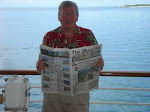 Trade and tourism make up a significant portion of the economy of Panama, and the picture at left exemplifies both. This was our third nation on our recent cruise, and to travel to Panama without looking at the Canal, would be like going to Vegas without throwing a quarter into a slot machine. So, after debarking on the Atlantic side in Colon (named after Christopher Columbus), we took a bus to the train, and rode the 48 miles to the Pacific side where we toured the Miraflores Locks.
Trade and tourism make up a significant portion of the economy of Panama, and the picture at left exemplifies both. This was our third nation on our recent cruise, and to travel to Panama without looking at the Canal, would be like going to Vegas without throwing a quarter into a slot machine. So, after debarking on the Atlantic side in Colon (named after Christopher Columbus), we took a bus to the train, and rode the 48 miles to the Pacific side where we toured the Miraflores Locks. Fourteen thousand vessels transit the waterway annually, and at present are limited by width and length of each ship. New locks under construction will expand width from 110 feet wide and 965 feet long, to an expanded 180 feet wide and 1,200 feet long. Those are expected to open in 2015, when the old locks turn 100 years of age. Prior to independence of "the zone", the Republic of Panama created a government institution by the name of the Panama Canal Authority (ACP for Autoridad del Canal de Panama in Spanish) to operate all aspects of the waterway.
The government of Panama took over the waterway officially at noon on December 31, 1999, per a treaty signed twenty-two years earlier by Jimmy Carter. The American military installations were turned over, and many were converted to trade or education facilities. One former Army base became a new Panamanian University, other facilities were sub-let by the new government to industry.
The actual railway across the isthmus was leased to The Panama Canal Railway Company, a joint venture between Kansas City Southern and an American inter-modal terminal operator. They were given 50 year lease, and proceeded to replace the aging trackbed with conventional gauge rail (it was narrow gauge before) and refurbish former AMTRAK cars used by tourists during the day, and one trip of businessmen traveling from Panama City in the west to the Colon Free Trade Zone on the Atlantic coast. At the end of the day, a return trip takes those same buyers back to the more populated Pacific side. Colon is the only significant population center on the Atlantic side - where the rains are heaviest due to the mountains in the center of the country. We would experience that same phenomenon in Costa Rica, where bananas are grown in the east, and most of the population is located alongside the Pacific coast.
So, this day had it all - a ship to the port, a bus to the rail head, a train to the Miraflores locks, and a bus ride and tour of Panama City, with return by bus across the country. The railway does not carry passengers as such - only tourists and those two trips for well-heeled buyers who commute between the capitol and the free trade zone in Colon (which our guide said was the second largest duty free zone in the world). Like Alice's Restaurant, "you can get anything you want" in the acres of warehouses in Colon on the Atlantic side. We settled for T-shirts again. Go figure


No comments:
Post a Comment